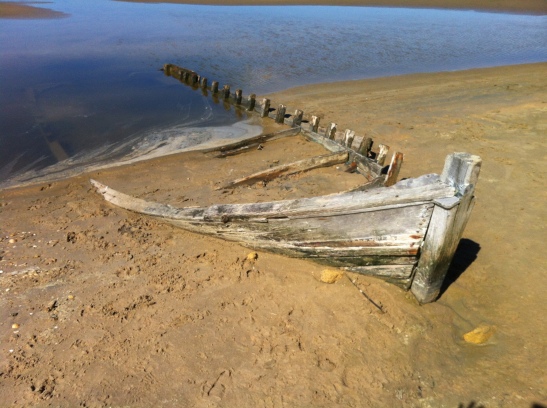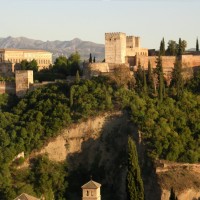Shuffling through the sand in Andalusia
That the English word ‘holiday’ derives from the Old English hāligdæg or holy day, whereas día de fiesta — the Spanish term for holiday — translates into ‘party day’, serves only to reinforce a telling cultural difference between the Spanish and the English.
Last Monday saw yet another día de fiesta here in the pueblo. What with the Romería picnic procession to El Colorado following closely on the heels of New Year, and not forgetting February’s extended carnival week ended less than a fortnight ago, life can seem like one long fiesta in the run-up to the Easter holidays. Nevertheless, Día de Andalucía, having fallen on Sunday this year, gave good enough reason to declare Monday a public holiday.
Día de Andalucía, or Andalusia Day, is mainly celebrated for having had the luck to be born Andalusian. Or maybe just for having the luck to be in Andalusia on Día de Andalucía. And what better way to recover from overdoing the celebrations than the Andalusian way: by having another fiesta day. After all, Leap Year had gifted Andalusians an extra day, so why not celebrate the occasion?
Soon after rising I could see it was going to be the perfect day for the sandy shuffle along the beach to El Palmar Angelica and I been promising ourselves for weeks. First, there’d be the tricky problem of tipping her out of bed. Yet another fiesta day in the endless number that follow in the wake of Christmas doesn′t make getting up any easier. A cup of tea helped.
With a bit of a picnic in mind — more school lunchbox than Fortnum & Mason hamper — we nipped down to Ambrosia′s for a pan Gallego, the crispy loaf with pointy ends that originates from Galicia, before they were all gone. Ambrosia is always proud to remind us her little grocery shop is open every day of the year, apart from Christmas Day.
Playa Castilnovo is the huge, gentle arc of virgin beach that stretches from Conil de la Frontera to the pueblecito of El Palmar. The shifting sands form an ever-changing band separating sea from a site of special scientific interest that too many concerns with special investment interests see as a wasted space that could better accommodate a luxury hotel and a golf course.
Though the sun blazed out of a cloudless blue sky, a light breeze bore enough chill onto it to put the roses in our cheeks.
The tide was well out by the time we reached the pedestrian bridge crossing the River Salado, where a generous sprinkling of strollers mingled to enjoy the fine spring weather. From the childlike excitement in the way everyone greeted their fellows, you’d never deduce public holidays are almost as common in Andalusia as Wednesdays are elsewhere in the world, quite a few of which seem to go missing round here. At least we can take comfort from the fact the occasional loss of such an uninspiring weekday brings the weekends closer together.
Once away from the throngs we saw a flash of long legs and long ears. A hare in a hurry dashed along the beach like there was no tomorrow, despite the fact Leap Year had brought an extra tomorrow the day before.
Though Conil was a thriving fishing pueblo long before the Romans came some believe the name originates out of a gradual corruption of the Latin term for rabbit cuniculus. Rabbits were classed as a type of hare by the Romans at a time when the entire Iberian penisula was overrun by the little buggers. Rabbits, not Romans. Though, thinking more about it, both could be held to be true, not that I want to waste everybody’s valuable time by pursuing such distractions. Another school of thought has it that both the origins of the pueblo’s name, and the Latin word for rabbit, lie in the extinct tongue known as Celtiberian. There does exist evidence for that theory, as in Catalan the word for rabbit is conill and in old French it is connil.
“In describing the region of Hispania of the first century B.C., the Roman poet Gaius Catullus spoke of “rabbit–filled Celtiberia” a fact which indicates that rabbits were already quite famous in Hispania by that time, at least for their abundance and rate of reproduction, if not for their physical appearance, since they were generally taken to be another type of hare.” from World Rabbit Science
To add emphasis to the point I′m trying to make, before I go off on another trail, a bit further along the World Rabbit Science article goes on to conclude: “…and the resulting words in Romance languages, such as conejo and conill … ”
Had it not been a Leap Year, posptoning the arrival of March for a day, I could’ve played on the idea of the hare being a March Hare. Oh, I’ve just done that.
In far less time than it took me to tap the first word of that brief diversion into etymology the hare was gone. And so was Angelica; before I could even start my little discourse. Maybe that was the very reason for her sudden disappearance. I caught up with her hiding behind a small sand dune.
Here and there, along the shoreline, a few well-equipped anglers on folding chairs sat patiently. Waiting for a bite they seemed to be keeping inordinately long stretches of beach between their neighbours and themselves. Through the eyes of a very occasional fisherman it looked like the only bite they might get would be on their cheeks in the unlikely event of the breeze turning frosty all of a sudden.
As the art of ambling involves a fair degree of lingering and loitering, it took a lot more than an hour for us to reach El Palmar. For most of the year, apart from high season, the little pueblecito is a magnet for surfers and barflies. There not being sufficient bars open to satisfy the unexpected demand, drinkers spilled out onto the road in front of those that were. Looking seawards, a small school of rubber-clad surfers were out trying to catch the ragged waves. Between strolling by bars and ogling their patrons, we chatted to a couple of stallholders out to make a euro or two while the sun shone. After a while the crowds proved overwhelming by comparison to the solitude of the beach we’d enjoyed so much. Turning round, we headed back to Conil, taking the path that borders the protected stretch of land by the beach this time.
Dunes that have eroded by the trampling of too many uncaring visitors have been fenced-off temporarily so grasses can re-establish themselves. Not not so much to pretty up the scenery, though that works too, but more as a protection against the encroaching sea. That didn’t stop a family of selfish picnickers ignoring signs telling them to keep off even though mile upon mile of deserted beach lay in front and to both sides of them.
The tower of Castilnovo, one of five fortified watchtowers built along the coast in the first half of the 17th century, lies midway between Conil and El Palmar, two kilometres south of Conil. Built to warn of – and guard against – Moorish attacks, it plays home to a few crotchety crows these days. Angelica and I settled down for our little picnic right next to it using a ruined wall as a windbreak. The tower didn’t only serve strategic military purposes, but, just short of fifty feet high, it also provided an ideal observation point to track the movement of tuna at almadraba, the tuna fishing season. At the base of the tower stood a collection of thick-walled stone buildings used for accommodation and storage, the ruins of which can be detected over quite a large area.
Chunks of pan Gallego, Iberian ham and Manchego cheese — made from sheep’s milk — swilled down with diluted apple juice may not sound like a great feast, but it certainly seemed like one after a few hours walking. We were soon revived enough to tackle the rest of the trek back.
The site of special scientific interest is known as such for its rare plants and wildflowers, as well as its migrating and indigenous birds. We spotted a peregrine falcon perched on a fence post along the way. They’re quite common in the area. Far less common, the Northern Bald Ibis is considered one of the ten most endangered birds in the world. Amazingly enough, Angelica and I had the luck to spot two pairs. Scratching about a carpet of spring vegetation they were looking for insects, reptiles and molluscs attracted by the rich variety of wild plants . Presumably the ibis we saw form part of the re-introduction programme being managed by the zoo and botanical gardens in nearby Jerez. The ibis mating season, which stretches from March to June, is just beginning. In my enlarged photo you can just about make the birds out. Reminder: must save up to get my talons on a proper camera this year.
The view of the plain stratching away to Vejer and Los Caños is always an excuse to grab a fresh breath on the slow uphill path from the river. I never tire of taking a shot. We’ll have to repeat the walk soon before the tourist season starts. Not that the beautiful beach on the other side of the river ever gets overcrowded, but, as the sun gets to searing point over summer, we people, who live in these parts all year round, prefer to stay in the shade.






















came back to enjoy the virtual tour after Angelina’s wake-up call and the hurrying hare. The leisurely pace of writing together with glimpses from your camera were a real bonus.. Conil and Cony Island evidently have something in common though the food and amusements are clearly classier in your barrio. I do hope there will be more tours planned
LikeLike
Though a few of my articles are being published on other web sites, and reaching a far wider audience, I still get a lot of pleasure knowing the faithful band of followers to this blog keep coming back for more. And it’s even better when they take the time to comment. You probably feel the same about your blogs, Laura. And there I have to admit, I’ve been a bit remiss about leaving comments of late, due to the pressure of work.
This year I plan to take a lot more local walks with Angelica, as we both have to force ourselves to relax. And, as neither of us drive, we hope to take a few bus trips to the many places of interest just an hour or two away.
LikeLiked by 2 people
good news that you’ve been busy & even better that there will be tours to come – my commenting goes in waves of all or nothing as real life calls sometimes
LikeLike
Hāligdæg sounds like our helligdag, not a party-day. Andalucia is wonderful place, and your portrait is very good! What I don’t like ist the boring sun, too much of it. 😉
LikeLiked by 1 person
But party days in Norway last an entire weekend, as I recall from the many times I’ve taken part. Especially round midsummer.
April to early June are the best months for this part of Andalucia in the first half of the year, and September to the end of October in the second half. The daytime weather is great and the nights are never too hot. Best of all, there aren’t too many holidaymakers. That’s the case in Conil, at least.
LikeLiked by 1 person
Sounds very good. Enjoy and have fun.
LikeLiked by 1 person
I enjoyed Andalucia it’s culture and landscape very much, but I’m sorry that I haven’t tried the Chunks of pan Gallego and I missed the día Andalucía! Does this also exist on the Canarian Islands? Thanks for your interesting post.
LikeLiked by 2 people
Pan Gallego probably exists on the Canaries, as for Día de Andalucía I’d imagine it might be celebrated by the large Andalucian community there, but not much beyond. Thanks for commenting, Martina.
LikeLiked by 1 person
Me too, Martina! 😉
LikeLiked by 2 people
Wow lovely sand😍😍 great post
LikeLiked by 1 person
check out my blog when you get the chance 🙂
LikeLike